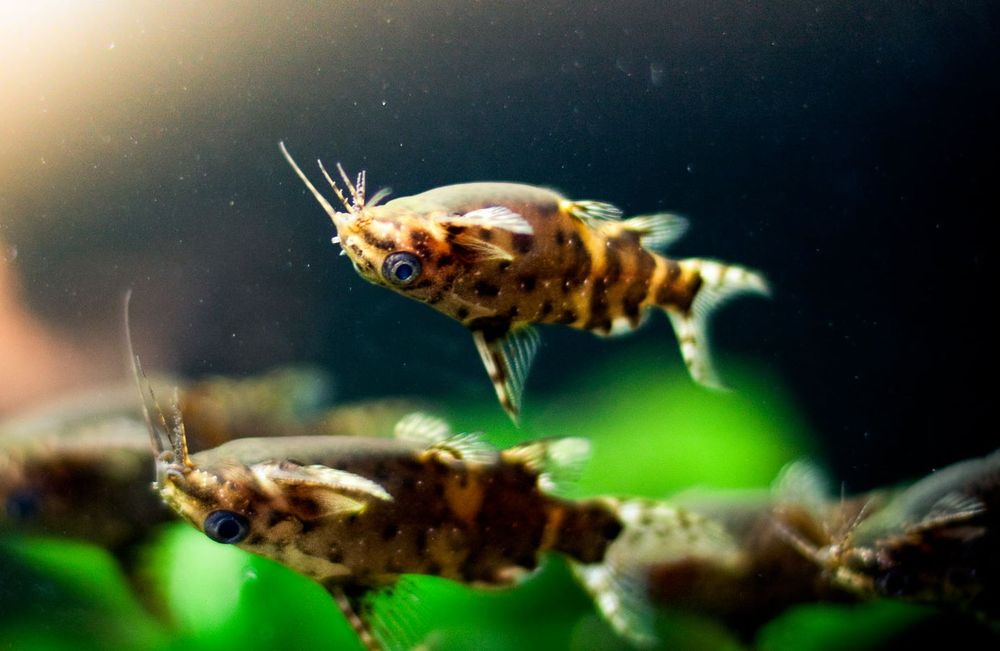Fishes are great swimmers, and this ability comes not from practice but from anatomy. Fishes have a slender body which they flex back and forth to cut through the water, and several fins that help them move, turn, stay upright, stop and so on. In addition, most fishes have an internal air sac called the swim bladder that allows them to control their buoyancy and orientation without having to continuously swim and thus expend energy. When fishes want to stay afloat, they gulp in air and inflate the bladder and when they want to sink they deflate it.
The swim bladder is located near the bellies, below their center of mass, which makes them prone to rolling. The fish tries to negate this effect by flapping its fins. But when the fish dies, it lose the ability to maintain equilibrium and the more buoyant part of their body tries to float to the surface, flipping their bodies upside down. A fish swimming on its side or floating with its belly up is a sure sign of injury or death, but for a few remarkable fishes, being upside down means everything is great.

An upside-down catfish. Photo: Ricky Romero/Flickr
There are several species of catfish of the genus Synodontis native to the Congo basin that naturally swim upside down. Their unusual behavior have been fascinating humans for centuries. The upside-down catfish have been carved into Egyptian tomb walls dating back 4,000 years. Pendants made in the shape of the upside-down catfish was a popular charm in ancient Egypt where it was thought to ward off drowning. Today, it is mostly found in aquariums, where they can live up to 15 years and grow, depending on the species, up to 20 inches long.
One theory is that the fish swim upside down for more efficient feeding. The fish often grazes on the undersides of submerged branches and logs, and swimming upside-down makes these areas more accessible. It is also more easier to catch preys such as insect larvae at the waterline when feeding from below. Swimming upside-down also makes it easier for the fish to ‘breath in’ the thin layer of oxygen rich water that’s available at the surface.

An ancient Egyptian gold pendant (ca. 1878-1749 BC) in the form of an upside-down catfish, now at the royal museum of Scotland in Edinburgh.
That ability can be critical for survival when the water becomes depleted of oxygen, a condition called hypoxia — which occurs naturally in some river systems, especially if they are marked by low light and dense vegetation, as in swamps.
“The upside-down catfish seems to have a whole suite of adaptations that make life at the surface more tenable,” said Lauren Chapman, a biology professor at McGill University who has been studying for more than two decades how fish respond to hypoxia in African river systems.
In one experiment, Chapman compared how upside-down and right-side-up catfish performed under low-oxygen conditions in a laboratory. She found that their swimming positions allowed the upside-down fish to breathe at the surface more easily, while the right-side-up ones had to work harder for the same benefit.
Although Chapman said that she could not say with certainty whether upside-down swimming evolved in response to hypoxia or some other factors influenced it, but for many fish in the wild, oxygen levels in the water can have a big impact, including increased gill size and smaller egg numbers, which eventually could lead to the formation of separate species.

Asian upside-down catfish. Photo: Charles Barilleaux/Flickr
Besides their breathing and feeding behavior, the upside-down catfish from the Congo Basin (Synodontis nigriventris) also known as the blotched upside-down catfish has also evolved to have darker bellies and lighter backs, so that when swimming upside down, the darker underside makes it harder to see against dark water. That coloration is remarkable because it’s the opposite of most fishes, which tend to be darker on top and lighter on the bottom. This is known as countershading.
It’s not that the upside-down catfish cannot swim right side up—it just prefers to swim inverted. The fish will often switch to ‘normal’ orientation when feeding at the bottom. Researchers at Nara Medical University School of Medicine in Japan, led by Ken Ohnishi found that the fish is more likely to be upside down around objects or at the water bottom. When close to an object, the fish turns its body over, probably to graze its underside. It rarely swims in the middle of the water, preferring to swim either at the bottom or at the surface.
References:
# The Mystery of the Upside-Down Catfish, KQED
# Lauren J. Chapman, Les Kaufman and Colin A. Chapman, Why Swim Upside down?: A Comparative Study of Two Mochokid Catfishes, Copeia
# Here’s why fish float upside down when they die, Insider



Comments
Post a Comment